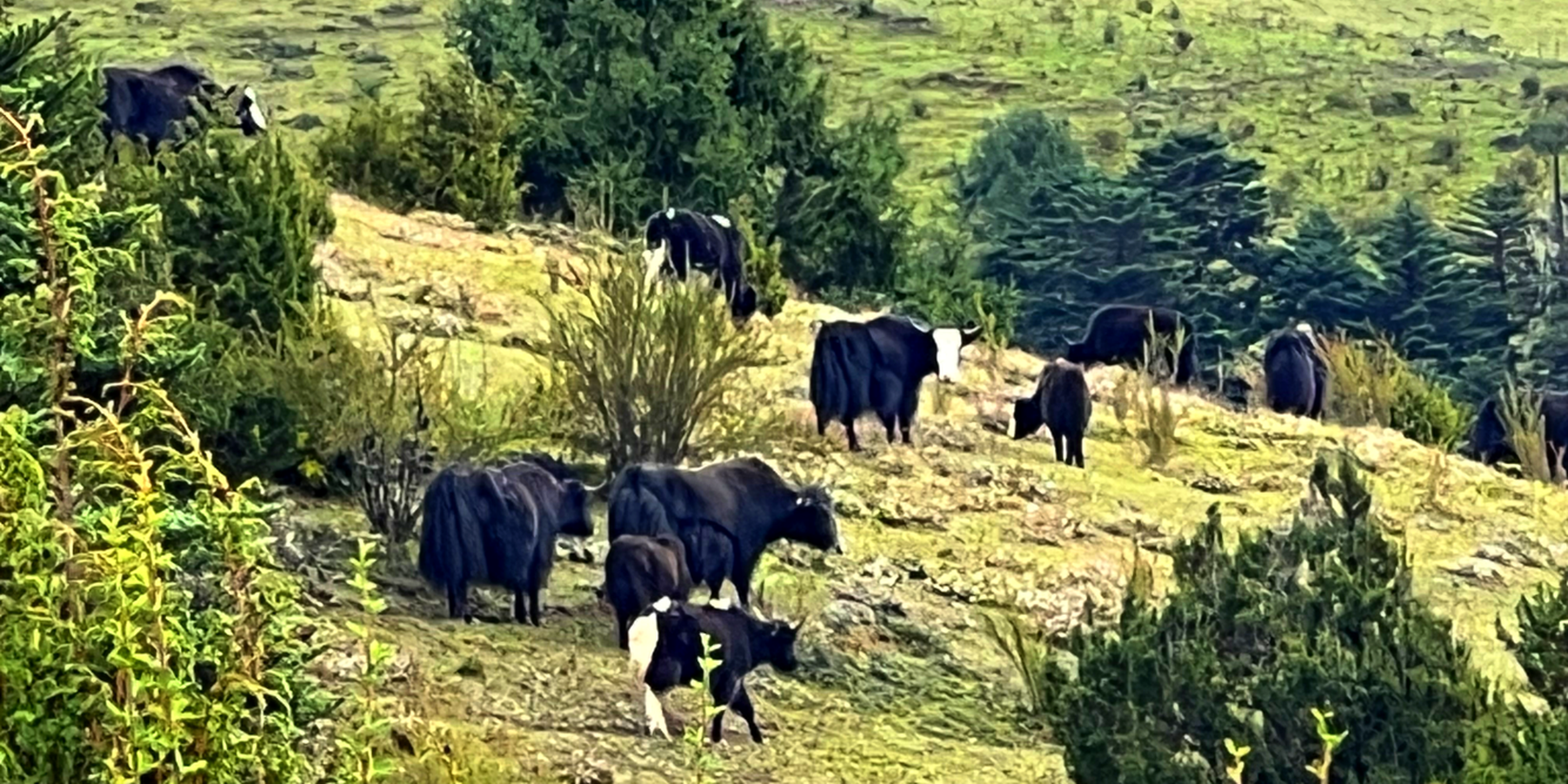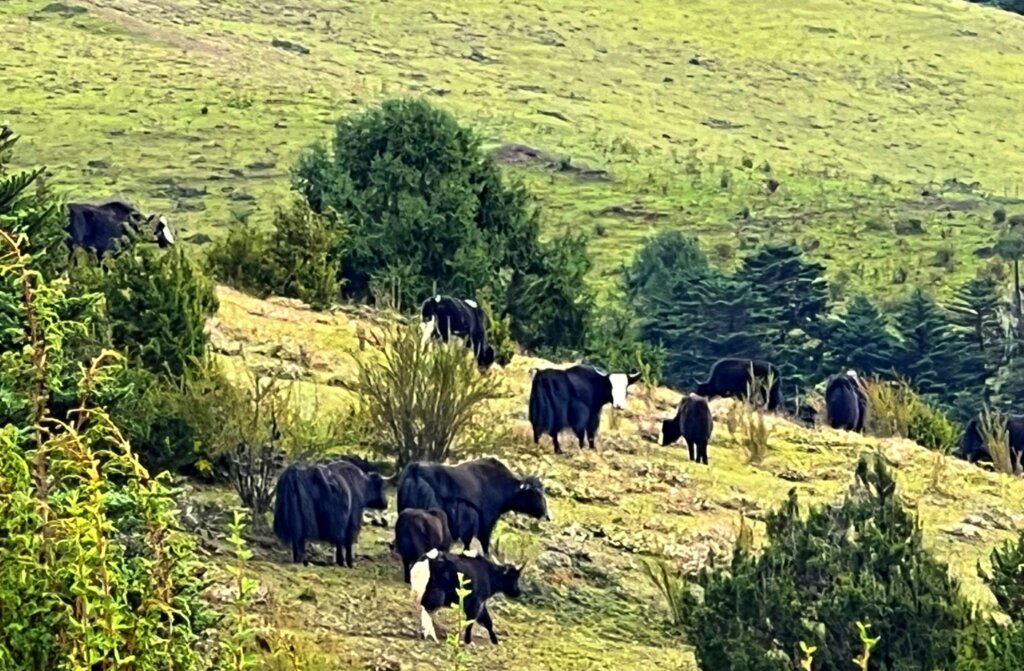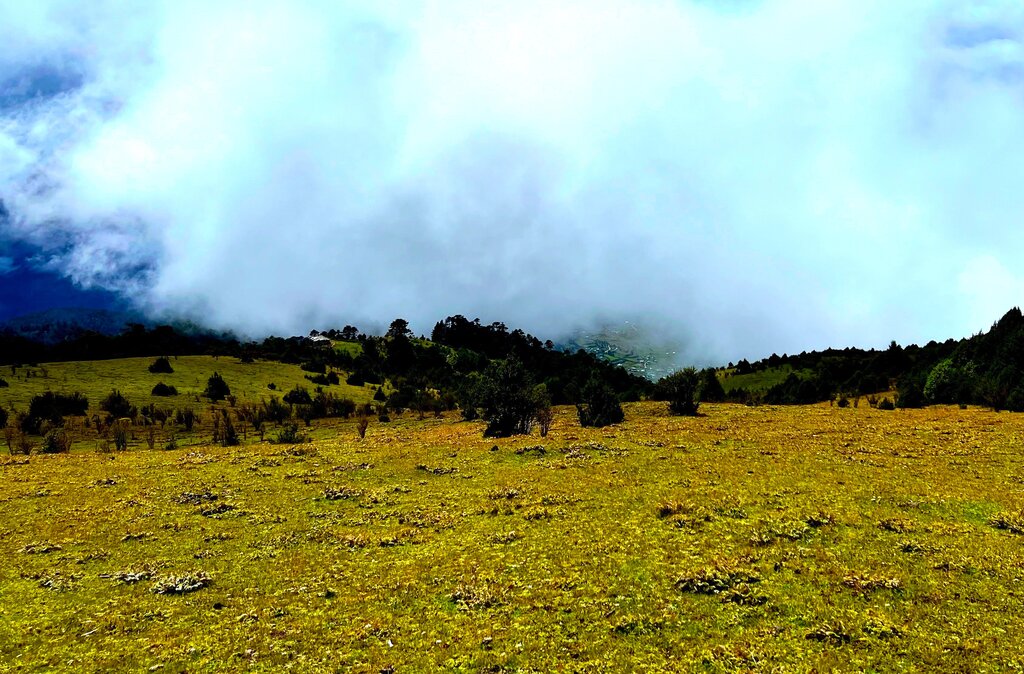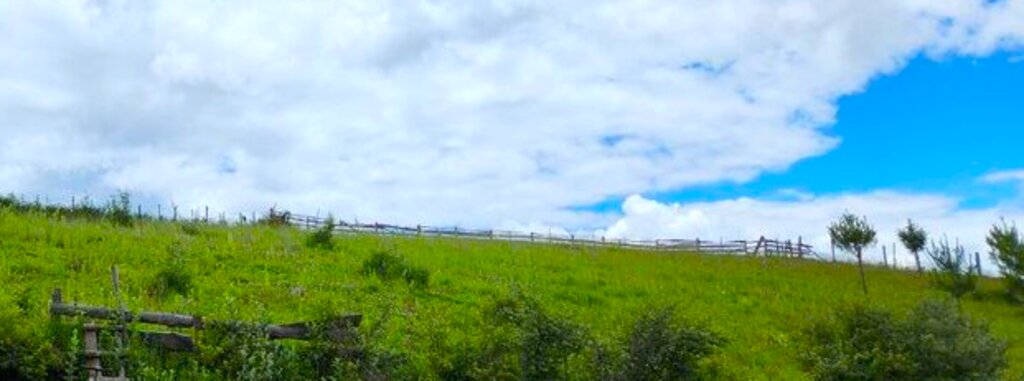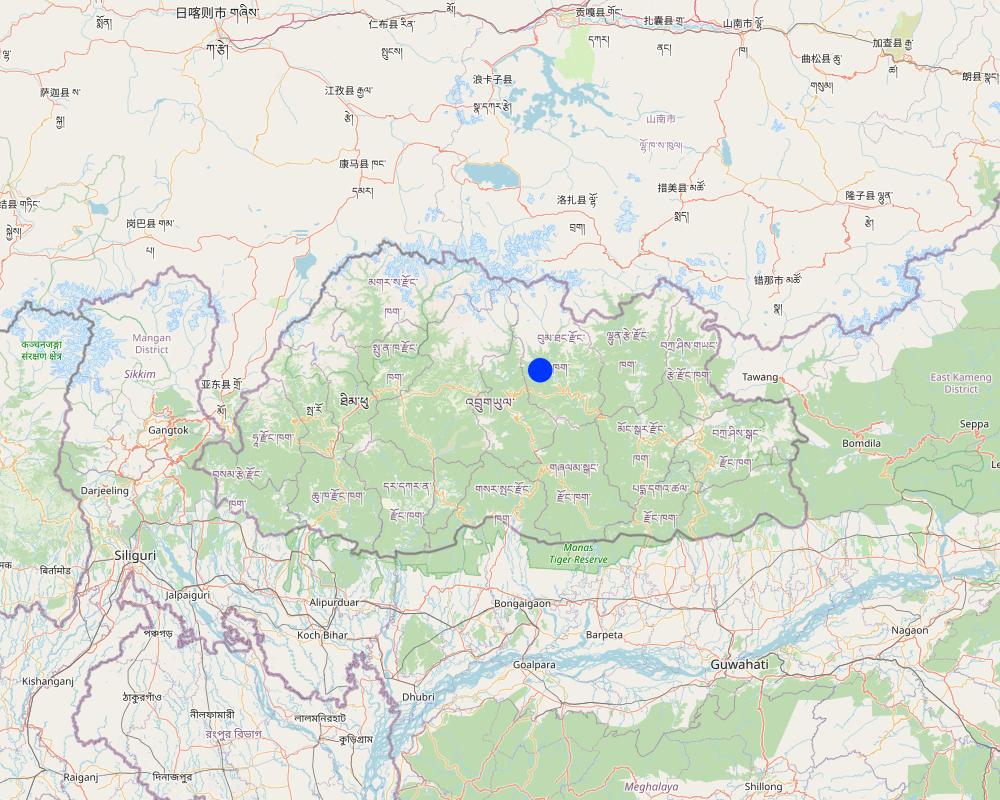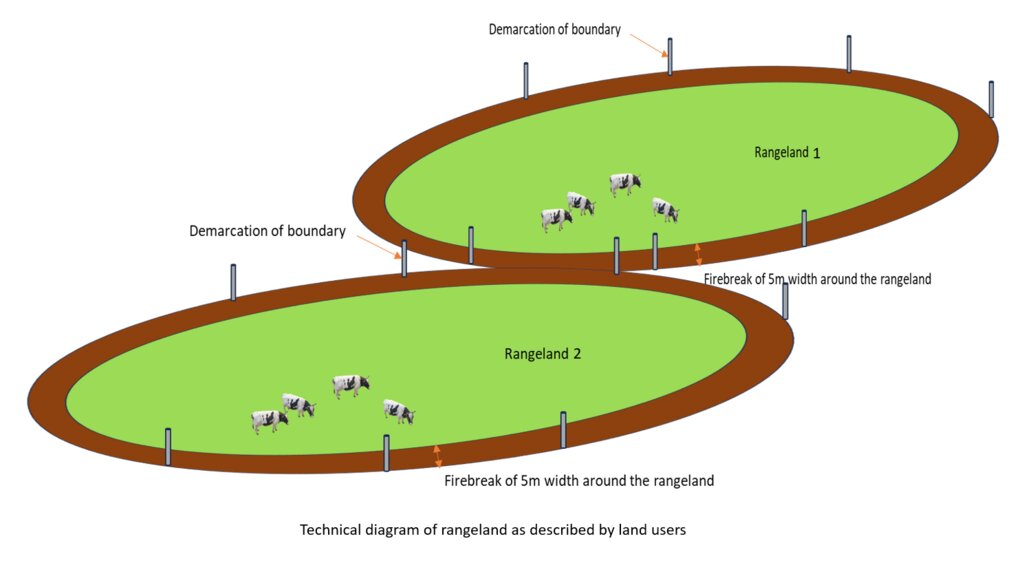Managed Burning of Rangeland [Butão]
- Criação:
- Atualização:
- Compilador/a: ONGPO LEPCHA
- Editor: chenga Tshering
- Revisores: William Critchley, Rima Mekdaschi Studer, Joana Eichenberger
Tshaezin Gi Thogley Meytang Tey Tsadrok Zinchong (ཚད་འཛིན་གྱི་ཐོག་ལས་མེ་བཏང་སྟེ་ཙྭ་འབྲོག་འཛིན་སྐྱོང་།)
technologies_6855 - Butão
Veja as seções
Expandir tudo Recolher tudo1. Informação geral
1.2 Detalhes do contato das pessoas capacitadas e instituições envolvidas na avaliação e documentação da tecnologia
Pessoa(s) capacitada(s)
usuário de terra:
Phurba
Dhur community
Butão
usuário de terra:
Phuntsho Kelzang
Dhur community
Butão
Nome do projeto que facilitou a documentação/avaliação da Tecnologia (se relevante)
Strengthening national-level institutional and professional capacities of country Parties towards enhanced UNCCD monitoring and reporting – GEF 7 EA Umbrella II (GEF 7 UNCCD Enabling Activities_Umbrella II)Nome da(s) instituição(ões) que facilitou(ram) a documentação/ avaliação da Tecnologia (se relevante)
National Soil Services Centre, Department of Agriculture, Ministry of Agriculture & Livestock (NSSC) - Butão1.3 Condições em relação ao uso da informação documentada através de WOCAT
O/a compilador/a e a(s) pessoa(s) capacitada(s) aceitam as condições relativas ao uso de dados documentados através da WOCAT:
Sim
1.4 Declaração de sustentabilidade da tecnologia descrita
A tecnologia descrita aqui é problemática em relação a degradação da terra de forma que não pode ser declarada uma tecnologia de gestão sustentável de terra?
Não
Comentários:
While this practice may be criticised on the basis of reducing biodiversity and leading to some GHG losses, it is an important land management practice that has certain specific benefits including making the land more productive.
2. Descrição da tecnologia de GST
2.1 Descrição curta da tecnologia
Definição da tecnologia:
Burning of rangeland (“tsamdro”) is a traditional management practice adopted by highlanders to control unpalatable grass and shrub species. This helps them produce adequate fodder for their yaks, cattle, horses, and sheep by creating a favorable environment for palatable grasses.
2.2 Descrição detalhada da tecnologia
Descrição:
The practice of burning rangeland (“tsamdro”) is a longstanding tradition among highlanders, whose livelihoods depend on livestock including yaks, cattle, horses and sheep. It is mainly practiced by transhumant communities or individuals who rely on livestock for their livelihoods. They follow a migratory livestock husbandry system that takes them from the highlands to the lowlands dependent on the availability of fodder resources, while simultaneously avoiding the extremes of climate. In the past, rangeland was allocated to individuals, communities, or religious bodies through payment for a minimal annual grazing permit, granting grazing rights. When pasture was scarce, controlled fires were intentionally set in specific areas to rejuvenate the rangeland with fresh grass and control unpalatable grasses and shrubs. For instance, the transhumant nomadic communities of Dhur village, Choekhor Gewog, in Bumthang have adopted the practice of burning rangeland. This practice is implemented during the winter months, dependent on weather, vegetation status, and wind patterns. Rooted in traditional knowledge and cultural practices, the practice is slowly diminishing nowadays due to environmental concerns and labour shortages as young nomads migrate - seeking better employment in towns.
The technique serves multiple purposes. These include promoting the growth of fresh and palatable pasture rich in protein, increasing plant diversity, adding nutrients to the soil through ash, and reducing dead plant material that inhibits new plant growth. Additionally, rangeland burning contributes to the control of livestock pests, especially ticks and flies. While rangeland burning is a straightforward process, it requires careful planning of time and location, creation of fire breaks to prevent uncontrollable spread, and leaving the land fallow for 2 to 3 years after burning to encourage grass growth.
Land users appreciate the technology for reducing their workload in collecting wild fodder grasses, enhancing visibility by removing trees and shrubs, and reducing the risk of predators. However, risks include the potential for uncontrolled fires if not properly managed and harm to the ecosystem and biodiversity in and around the pastureland. Burning also contributes to the loss of carbon dioxide (a greenhouse gas) to the atmosphere.
2.3 Fotos da tecnologia
2.5 País/região/locais onde a tecnologia foi aplicada e que estão cobertos nesta avaliação
País:
Butão
Região/Estado/Província:
Bumthang Dzongkhag (District)
Especificação adicional de localização:
Dhur village, Choekhor Gewog (Block)
Especifique a difusão da tecnologia:
- Uniformemente difundida numa área
Se a área precisa não for conhecida, indicar a área aproximada coberta:
- 0,1-1 km2
O(s) local(is) tecnológico(s) está(ão) localizado(s) em uma área permanentemente protegida?
Não
Comentários:
The total area of rangeland owned was 70 acres (from the two individual who the enumerators interviewed)
Map
×2.6 Data da implementação
Caso o ano exato seja desconhecido, indique a data aproximada:
- mais de 50 anos atrás (tradicional)
2.7 Introdução da tecnologia
Especifique como a tecnologia foi introduzida:
- Como parte do sistema tradicional (>50 anos)
Comentários (tipos de projeto, etc.):
Traditional practice of burning rangeland was adopted by the transhumant nomadic community of Dhur village called the Bjobs since time immemorial.
3. Classificação da tecnologia de GST
3.1 Principal/principais finalidade(s) da tecnologia
- Melhora a produção
3.2 Tipo(s) atualizado(s) de uso da terra onde a tecnologia foi aplicada
Uso do solo misturado dentro da mesma unidade de terra:
Sim
Especificar o uso misto da terra (culturas/ pastoreio/ árvores):
- Silvipecuária

Pastagem
Pastagem extensiva:
- Nomadismo
- Pasture grass is natural grown and livestock are allowed to graze on it
- Yak
É praticado o manejo integrado de culturas e pecuária?
Não
Produtos e serviços:
- carne
- leite
- peles/couros
Espécie:
gado - lácteo
Contagem:
50
Espécie:
gado - lácteo
Contagem:
55

Floresta/bosques
- Florestas/bosques (semi)naturais
Florestas (semi)naturais/ bosques: Especificar o tipo de manejo:
- Retirada de madeira morta/podas
Tipo de floresta (semi)natural:
- vegetação natural de sistemas montanhosos temperados
- Pine, Chirpine, Fir and Cypress
As árvores especificadas acima são decíduas ou perenes?
- perene
Produtos e serviços:
- Conservação/proteção da natureza
3.3 O uso do solo mudou devido à implementação da Tecnologia?
O uso do solo mudou devido à implementação da Tecnologia?
- Não (Continuar com a pergunta 3.4)
3.4 Abastecimento de água
Abastecimento de água para a terra na qual a tecnologia é aplicada:
- Precipitação natural
Comentários:
There are water sources in their summer pasture lands; however, for the growth of the pasture grass, water supply is mostly dependent on rain.
3.5 Grupo de GST ao qual pertence a tecnologia
- Gestão de pastoralismo e pastagem
3.6 Medidas de GST contendo a tecnologia

Medidas de gestão
- M5: Controle/mudança de composição de espécies
Comentários:
The main SLM measure includes the burning of rangeland to regenerate palatable grass species. In the process of burning invasive species are killed, and the desired clearing of weeds is achieved finally resulting in an environment with fresh grasses for livestock.
3.7 Principais tipos de degradação da terra abordados pela tecnologia

Outro
Especifique:
Revitalise and regenerate growth of palatable grass species to be used for livestock grazing
Comentários:
This technology do not address land degradation issue .
3.8 Redução, prevenção ou recuperação da degradação do solo
Especifique o objetivo da tecnologia em relação a degradação da terra:
- Não aplicável
Comentários:
It is used to regenerate and revitalise growth of palatable grass species.
4. Especificações técnicas, implementação de atividades, entradas e custos
4.1 Desenho técnico da tecnologia
Especificações técnicas (relacionada ao desenho técnico):
Firebreak of 5 m are kept to control the burning
Autor:
Ongpo Lepcha
Data:
16/02/2024
4.2 Informação geral em relação ao cálculo de entradas e custos
Especifique como custos e entradas foram calculados:
- por área de tecnologia
Indique o tamanho e a unidade de área:
1 acres
Se utilizar uma unidade de área local, indicar fator de conversão para um hectare (por exemplo, 1 ha = 2,47 acres): 1 ha =:
0.4 hectare
Outro/moeda nacional (especifique):
Bhutanese Ngultrum
Se for relevante, indique a taxa de câmbio do USD para moeda local (por exemplo, 1 USD = 79,9 Real): 1 USD =:
82,08
Indique a média salarial da mão-de-obra contratada por dia:
1200
4.3 Atividades de implantação
| Atividade | Periodicidade (estação do ano) | |
|---|---|---|
| 1. | Creating fire break around the pasture land | During the winter season |
| 2. | Burning of the pasture land | During the winter season |
| 3. | After burning the land is left fallow for the pasture land to establish | Kept fallow for the next 2 to 3 years |
4.4 Custos e entradas necessárias para a implantação
| Especifique a entrada | Unidade | Quantidade | Custos por unidade | Custos totais por entrada | % dos custos arcados pelos usuários da terra | |
|---|---|---|---|---|---|---|
| Mão-de-obra | Labours | person-days | 9,0 | 1200,0 | 10800,0 | 98,0 |
| Equipamento | grass cutter | No | 1,0 | 15000,0 | 15000,0 | |
| Equipamento | Pipe | Bundle | 1,0 | 3000,0 | 3000,0 | |
| Equipamento | Spade | No | 3,0 | 500,0 | 1500,0 | |
| Custos totais para a implantação da tecnologia | 30300,0 | |||||
| Custos totais para o estabelecimento da Tecnologia em USD | 369,15 | |||||
Comentários:
The cost for the pasture burning is very minimal and even the labours normally are from their own household.
4.5 Atividades recorrentes/manutenção
| Atividade | Periodicidade/frequência | |
|---|---|---|
| 1. | Land is left fallow | For 2 to 3 years |
Comentários:
The rangeland after burning is left fallow for the next 2 to 3 years. During that time, the land user would graze their yaks in other pasture land.
4.6 Custos e entradas necessárias pata a manutenção/atividades recorrentes (por ano)
Comentários:
Expenditure not incurred for the maintenance of the technology.
4.7 Fatores mais importantes que afetam os custos
Descreva os fatores mais determinantes que afetam os custos:
Labour cost
5. Ambiente natural e humano
5.1 Clima
Precipitação pluviométrica anual
- <250 mm
- 251-500 mm
- 501-750 mm
- 751-1.000 mm
- 1.001-1.500 mm
- 1.501-2.000 mm
- 2.001-3.000 mm
- 3.001-4.000 mm
- > 4.000 mm
Especificações/comentários sobre a pluviosidade:
The data was used from the National Center for Hydrology and Meteorology from the nearest weather station.
Indique o nome da estação meteorológica de referência considerada:
https://www.nchm.gov.bt/home/pageMenu/906
Zona agroclimática
- Semiárido
Cool temperate zone
5.2 Topografia
Declividade média:
- Plano (0-2%)
- Suave ondulado (3-5%)
- Ondulado (6-10%)
- Moderadamente ondulado (11-15%)
- Forte ondulado (16-30%)
- Montanhoso (31-60%)
- Escarpado (>60%)
Formas de relevo:
- Planalto/planície
- Cumes
- Encosta de serra
- Encosta de morro
- Sopés
- Fundos de vale
Zona de altitude:
- 0-100 m s.n.m.
- 101-500 m s.n.m.
- 501-1.000 m s.n.m.
- 1.001-1.500 m s.n.m.
- 1.501-2.000 m s.n.m.
- 2.001-2.500 m s.n.m.
- 2.501-3.000 m s.n.m.
- 3.001-4.000 m s.n.m.
- > 4.000 m s.n.m.
Indique se a tecnologia é aplicada especificamente em:
- Não relevante
5.3 Solos
Profundidade do solo em média:
- Muito raso (0-20 cm)
- Raso (21-50 cm)
- Moderadamente profundo (51-80 cm)
- Profundo (81-120 cm)
- Muito profundo (>120 cm)
Textura do solo (solo superficial):
- Médio (limoso, siltoso)
Matéria orgânica do solo superficial:
- Alto (>3%)
5.4 Disponibilidade e qualidade de água
Disponibilidade de água de superfície:
Bom
Qualidade da água (não tratada):
Água potável boa
A qualidade da água refere-se a:
água de superfície
A salinidade da água é um problema?
Não
Ocorre inundação da área?
Não
5.5 Biodiversidade
Diversidade de espécies:
- Baixo
Diversidade de habitat:
- Baixo
Comentários e outras especificações sobre biodiversidade:
Since, only grasses are grown in the land, the species and habitat diversity is very low. Other factors that determine low diversity could be due to low temperature.
5.6 Características dos usuários da terra que utilizam a tecnologia
Sedentário ou nômade:
- Nômade
Orientação de mercado do sistema de produção:
- misto (subsistência/comercial)
Rendimento não agrícola:
- >50% de toda renda
Nível relativo de riqueza:
- Rico
Indivíduos ou grupos:
- Indivíduo/unidade familiar
Nível de mecanização:
- Trabalho manual
Gênero:
- Homens
Idade dos usuários da terra:
- idosos
Indique outras características relevantes dos usuários da terra:
The land users were currently retired and had their sons and daughters to take care of their yaks.
5.7 Área média de terrenos utilizados pelos usuários de terrenos que aplicam a Tecnologia
- < 0,5 ha
- 0,5-1 ha
- 1-2 ha
- 2-5 ha
- 5-15 ha
- 15-50 ha
- 50-100 ha
- 100-500 ha
- 500-1.000 ha
- 1.000-10.000 ha
- > 10.000 ha
É considerado pequena, média ou grande escala (referente ao contexto local)?
- Grande escala
Comentários:
One of the interviewees had 50 acres of pasture land, while the other had 20 acres of pasture land.
5.8 Propriedade de terra, direitos de uso da terra e de uso da água
Propriedade da terra:
- Indivíduo, intitulado
Direitos do uso da terra:
- Indivíduo
Direitos do uso da água:
- Acesso livre (não organizado)
Os direitos de uso da terra são baseados em um sistema jurídico tradicional?
Sim
Especifique:
The traditional legal system in our country is as per the land act and rules and regulations which dictate the land use in the country.
5.9 Acesso a serviços e infraestrutura
Saúde:
- Pobre
- Moderado
- Bom
Educação:
- Pobre
- Moderado
- Bom
Assistência técnica:
- Pobre
- Moderado
- Bom
Emprego (p. ex. não agrícola):
- Pobre
- Moderado
- Bom
Mercados:
- Pobre
- Moderado
- Bom
Energia:
- Pobre
- Moderado
- Bom
Vias e transporte:
- Pobre
- Moderado
- Bom
Água potável e saneamento:
- Pobre
- Moderado
- Bom
Serviços financeiros:
- Pobre
- Moderado
- Bom
Comentários:
Access to these services and infrastructure were based on their winter home, during the summer they would travel to the more higher altitudes where none of these services are available except for drinking water.
6. Impactos e declarações finais
6.1 Impactos no local mostrados pela tecnologia
Impactos socioeconômicos
Produção
Produção de forragens
Comentários/especificar:
The land users shared that fodder production is relatively higher when practicing rangeland burning.
Qualidade da forragem
Comentários/especificar:
When comparing cut grass and grass in burned rangeland, the land users prefer the grass in the burned rangeland.
Produção animal
Comentários/especificar:
According to the land users, milk yield is better and higher from cattle fed on grasses from rangeland, which was burnt previously.
Risco de falha de produção
Comentários/especificar:
Land user also shared that burning rangeland provides enough food for their livestock which is sufficient throughout the year. This reduces the risk of production due to a shortage of grasses/feed.
Renda e custos
Rendimento agrícola
Comentários/especificar:
Farm income is higher when compared to dairy supplemented with commercial feed in the winter. In addition, the establishment cost and implementation cost is also very low.
Carga de trabalho
Comentários/especificar:
According to the nomads, burning rangeland is easier and requires less amount of energy for establishment.
Impactos socioculturais
Conhecimento de GST/ degradação da terra
Comentários/especificar:
Land users observed healthy grasses growing after burning rangeland. This indicated that burning also adds to soil fertility.
Impactos ecológicos
Biodiversidade: vegetação, animais
Cobertura vegetal
Comentários/especificar:
Vegetation cover is reduced because of this technology. This is because shrubs and trees are intentionally removed from the rangeland.
Diversidade vegetal
Comentários/especificar:
Plant diversity is also very minimal since tree saplings and shrubs are burned leaving only the pasture grass to grow on the land
Diversidade de habitat
Comentários/especificar:
Only grass is maintained as part of the technology. Habitat diversity is very low as trees and shrubs which also serve as habitats for many insects and arthropods are removed from rangeland.
Controle de praga/doença
Comentários/especificar:
It is reported in the literature that rangeland burning can reduce pest like tick and flies.
6.2 Impactos externos mostrados pela tecnologia
Impacto dos gases de efeito estufa
Comentários/especificar:
Burning of the rangeland leads to the production of several greenhouse gases, inevitably.
6.3 Exposição e sensibilidade da tecnologia às mudanças climáticas graduais e extremos/desastres relacionados ao clima (conforme o ponto de vista dos usuários da terra)
Mudança climática gradual
Mudança climática gradual
| Estação do ano | aumento ou diminuição | Como a tecnologia lida com isso? | |
|---|---|---|---|
| Temperatura anual | aumento | bem | |
| Precipitação pluviométrica anual | redução/diminuição | bem |
Extremos (desastres) relacionados ao clima
Desastres meteorológicos
| Como a tecnologia lida com isso? | |
|---|---|
| Temporal local | bem |
| Trovoada local | muito bem |
| Tempestade de granizo local | bem |
| Tempestade de neve local | bem |
| Tempestade de vento local | muito bem |
Desastres climatológicos
| Como a tecnologia lida com isso? | |
|---|---|
| Onde de frio | bem |
| Seca | bem |
| Incêndio florestal | não bem |
Desastres hidrológicos
| Como a tecnologia lida com isso? | |
|---|---|
| Deslizamento de terra | bem |
6.4 Análise do custo-benefício
Como os benefícios se comparam aos custos de implantação (do ponto de vista dos usuários da terra)?
Retornos a curto prazo:
muito positivo
Retornos a longo prazo:
muito positivo
Como os benefícios se comparam aos custos recorrentes/de manutenção(do ponto de vista dos usuários da terra)?
Retornos a curto prazo:
muito positivo
Retornos a longo prazo:
muito positivo
Comentários:
Since minimal cost goes into implementing the technology, the income earned from it is high. Further, the land users also earn income from cordyceps, therefore, off farm income is very high than from dairy produced from the cattles.
6.5 Adoção da tecnologia
- 11-50%
Se disponível, determine a quantidade (número de unidades familiares e/ou área abordada):
17 households from a total of 105 household in the village are land users and practice rangeland burning.
De todos aqueles que adotaram a Tecnologia, quantos o fizeram espontaneamente, ou seja, sem receber nenhum incentivo/ pagamento material?
- 91-100%
Comentários:
Burning of the rangeland has been practiced by all the land users for a very long period of time.
6.6 Adaptação
A tecnologia foi recentemente modificada para adaptar-se as condições variáveis?
Não
6.7 Pontos fortes/vantagens/oportunidades da tecnologia
| Pontos fortes/vantagens/oportunidades na visão do usuário da terra |
|---|
| Feed security for livestock: Land users have high-quality grasses in enough quantity to feed his/her cattle for the seasons. |
| The land is revitalized for better growth of the pasture grass: fresh and healthy grasses growing after the burning of rangeland are rich in protein and enhanced digestibility |
| Less workload: Implementation of this technology is easy and land users have enough time to di off-farm activities. |
| Pontos fortes/vantagens/oportunidades na visão do/a compilador/a ou de outra pessoa capacitada |
|---|
| Rangeland burning helps control the spread of woody plants and invasive species. |
| Rangeland burning has cultural significance and is deeply rooted in traditional knowledge and practices. |
6.8 Pontos fracos, desvantagens/riscos da tecnologia e formas de superá-los
| Pontos fracos/desvantagens/riscos na visão do usuário da terra | Como eles podem ser superados? |
|---|---|
| Can lead to forest fire | Land users should create fire break to prevent the fire from becoming uncontrollable |
| Affect ecosystem and biodiversity in and around the pasture land | Using better varieties of pasture grass. |
| Pontos fracos/vantagens/riscos na visão do/a compilador/a ou de outra pessoa capacitada | Como eles podem ser superados? |
|---|---|
| Intense fires or repeated burning in the same areas can lead to increased soil erosion. | Implementing proper rotational burning practices, where different areas of the rangeland are burned in a planned sequence. |
| Rangeland burning can produce smoke and affect air quality and add carbon dioxide (green house gases) to the atmosphere. | Burns should be carried out under favorable weather conditions, taking into account wind direction and dispersion patterns. |
7. Referências e links
7.1 Métodos/fontes de informação
- visitas de campo, pesquisas de campo
One household as representative of other household involved.
- entrevistas com usuários de terras
Two individuals
Quando os dados foram compilados (no campo)?
17/07/2023
7.2 Referências às publicações disponíveis
Título, autor, ano, ISBN:
Mapiye, C., Mwale, M., Chikumba, N. & Chimonyo, M. (2008). Fire as a Rangeland Management Tool in the Savannas of Southern Africa. Tropical and Subtropical Agroecosystems, 8, 115-124.
Disponível de onde? Custos?
https://www.redalyc.org/pdf/939/93980201.pdf
Título, autor, ano, ISBN:
Sabiiti, E. N., Wamara, J. B., Ogen-Odoi, A. A. & Wein, R. W. (1992). The Role of Fire in Pasture and Rangeland Management. Nomadic Peoples, 21, 107-110.
Disponível de onde? Custos?
https://www.jstor.org/stable/43123378
7.3 Links para informações on-line relevantes
Título/ descrição:
Management Strategies for Rangeland and Introduced Pastures
URL:
https://extension.okstate.edu/fact-sheets/management-strategies-for-rangeland-and-introduced-pastures.html
Título/ descrição:
Fire as a Tool in Land Management
URL:
https://rangelandsgateway.org/topics/rangeland-ecology/fire-tool-land-management
7.4 Comentários gerais
Some questions in the questionnaire were not related to Bhutanese context. So we left out those question without any response.
Links e módulos
Expandir tudo Recolher tudoLinks
Não há links
Módulos
Não há módulos


